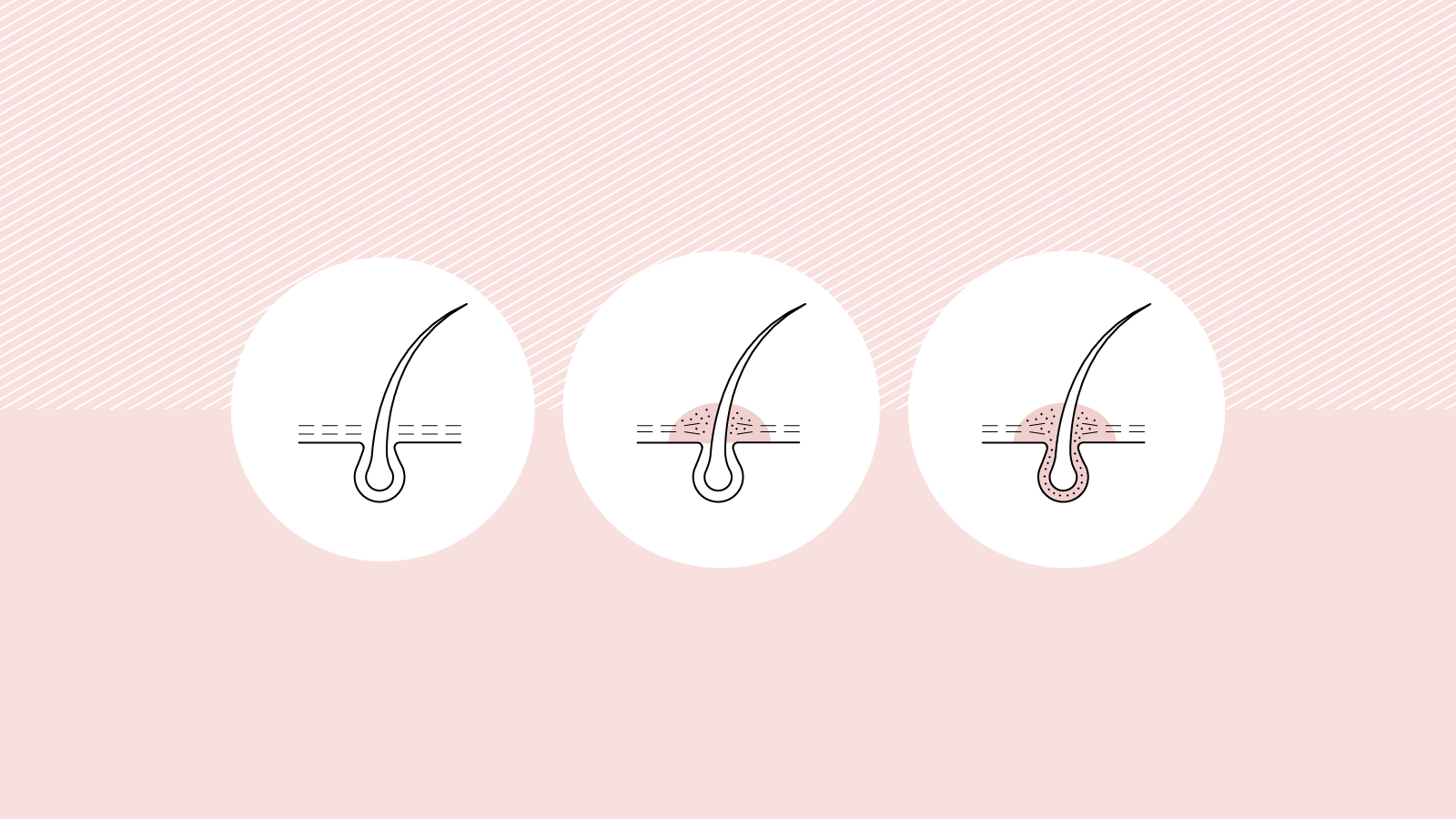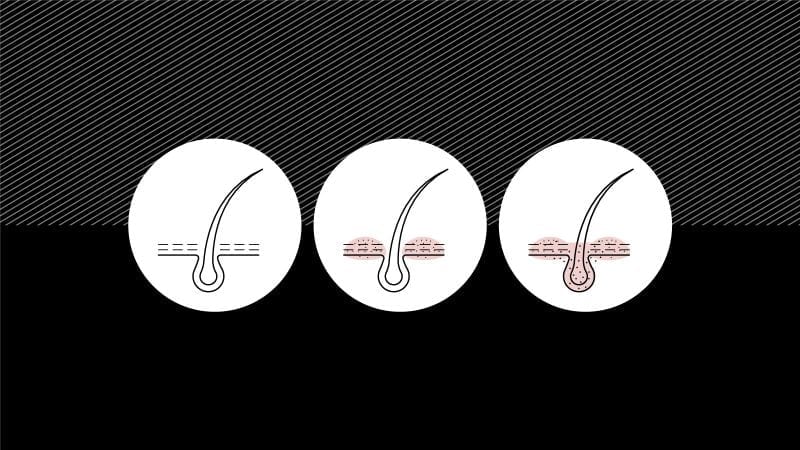What Is Folliculitis and how to treat it?
Folliculitis is a common condition caused by a bacterial or fungal infection of the hair follicles. When it starts the hair follicles swell and tiny red or white pimples develop on the skin. If left untreated this can develop into a serious infection. Folliculitis can be superficial or deep, depending on how much of the follicle is affected. Deep folliculitis can result in scarring or permanent hair loss. Find out what is folliculitis and how to treat it in our detailed post below.
What does it feel like?
This condition can cause discomfort, be painful, irritating, itchy and embarrassing. Mild cases usually disappear within a few days but more severe cases may need medical treatment. In areas where hairs are thicker ie men’s beards, underarms and bikini line cases may be more severe and last longer. Damaged follicles are also at risk of becoming infected.
Why is laser hair removal a good option for folliculitis?
Laser hair removal can help minimise the effects of folliculitis on hair follicles. Although it cannot completely prevent this condition it may help lessen the severity of it. Laser hair removal over time will reduce hair growth. When hair has been removed the opening of the follicle will tighten as there are no thick hairs protruding onto the skin surface. This makes it harder for bacteria to enter the follicle and cause inflammation associated with this condition.
Although laser hair removal can help with this condition it is not a miracle cure. It is important to note that if folliculitis is reoccurring due to underlying health issue laser hair removal may not offer a long term solution to this problem.
What is the most common area on the body that is affected by it?
Folliculitis can occur anywhere on the body that hair grows. The most common areas that are affected are the face. Men’s beards and back of the neck in particular. It can also affect the body, most commonly the underarms, buttocks, bikini line and legs.
What does folliculitis look like?
- Skin will appear very red
- Clusters of red and white pimples around hair follicles will appear
- Blisters full of pus that break open and form a crust
- Cysts, Boils may form under the skin
What causes folliculitis?
- Bacteria (Staphylococcus aureus)
- Viruses
- Fungi
- Inflammation from ingrown hairs
- Excessive Sweating (hyperhidrosis)
- Steroid creams
How can hair follicles become damaged?
- Rough shaving technique
- Incorrect waxing technique
- Incorrect use of an epilator
- Constantly wearing tight clothing
- Over time reoccurring infections if severe can result in damage to the follicles
What are the different types of folliculitis?
The most common superficial types are:
Bacterial
Follicles become infected with Staphylococcus (Staph) bacteria. This type of bacteria lives on the body at all times and only causes a problem when it enters through a cut or wound. This is why this type is the most common, especially on men’s faces due to daily shaving routines.
Pseudo folliculitis barbae
This type is a little different from the rest because it is due to ingrowing hairs. It does look similar but spots that form on the skin do not become infected with pus.
Hot Tub folliculitis
Follicles become infected by Pseudomonas bacteria. This type of bacteria lives in hot tubs and heated swimming pools and can multiply if chlorine or pH levels are not maintained properly.
How to treat superficial folliculitis?
These types normally improve in a 7-10 day period and do not need any medical intervention. By following the guidelines below, the condition should improve over a short period of time. If there is no improvement your doctor will prescribe a topical product to help clear this up. Antibiotics are not needed for the majority of these cases.
The most common deep types of this condition are
Sycosis barbae
This type occurs in the beard area of men. Shaving can make this condition worse as the razor will open any pustules in the area and spread infection over the skin. As hair follicles grow very close together infection can spread quite quickly over a small area. If left untreated this condition can lead to long term scarring.
Gram-negative folliculitis
This type may occur if you are taking antibiotics for long periods to treat acne. Gram-negative is a type of bacteria found in the nose. After a course of antibiotics, this bacteria can spread to the surrounding skin and nose producing a new outbreak of acne.
Boils
If hair follicles become infected with large quantities of staph bacteria a furuncle, or boil, can form on the skin. They are much larger than a pustule and are very tender and sore to touch. Boils will continue to fill with pus and fluid until eventually they burst and drain. This can sometimes leave deep pitted scars on the skin. Boils can develop into a cluster, causing a carbuncle and this can lead to deeper scarring as the infection is more severe.
How to treat deep folliculitis?
The majority of these cases need medical intervention and should be referred to a dermatologist. Leaving this condition untreated may result in permanent hair loss and deep pitted scarring.
What can you do to treat folliculitis when infection is active?
- Avoid shaving, waxing, epilating or plucking the area.
- Do not pick pustules
- Change bedding/nightwear daily while the infection is active
- Use fresh towels after shower/bath
- Avoid using body brushes/loofahs
- Do not apply perfumed products to the affected areas
- Store 100% Aloe Vera in the fridge and apply to the area frequently to help the itch
- Avoid using swimming pools, saunas, hot tubs until infection has cleared
- Avoid activities that would cause you to sweat excessively
- Drink water to help keep skin hydrated
- Keep skin in the infected area clean
- Do not use excessively hot water in the shower/bath
- Apply a fragrance-free moisturiser to the area ie. Cetaphil, Aveeno
- If infections are reoccurring it may be a sign of an underlying issue
Are there any ways to prevent folliculitis reoccurring?
- After shaving thoroughly wash your razor and dry it.
- Spray it lightly with a natural antiseptic like tea tree or witch hazel
- Replace the protective cap and store it in a dry place away from steam
- Use a new razor blade every time you shave if infection is severe
- If shaving multiple areas be careful not to spread infection from one area to another
- Avoid shaving the area for a short period of time to allow skin to heal
- Change your pillow/bedding more frequently
- Use fresh towels/facecloths each time you shower/bathe
- Use tepid water when showering or bathing
- Avoid constantly wearing tight clothes
- Keep your skin cool as exposure to heat may make this condition worse
- Consider laser hair removal, laser will weaken the hairs over time
- Be cautious of using hot tubs or heated pools if you are susceptible to folliculitis
Do I need to seek medical advice for folliculitis?
Most cases of superficial folliculitis clear up within a 7-10 day time period. Make sure to follow the simple steps in the section above. If you do not see any improvement after this time you may need to make an appointment with your GP to discuss treatment options. In some cases of deep folliculitis, boils and carbuncles may need to be surgically drained by a doctor or nurse. This is needed in order to minimise the risk of long term deep scarring. Now you know what folliculitis is and how best to treat it. Laser hair removal will definitely help this condition for you.
If you have any further questions regarding folliculitis and how to treat it please do not hesitate to contact us. Our dedicated team of hair removal specialists are on hand to answer any of your questions.


